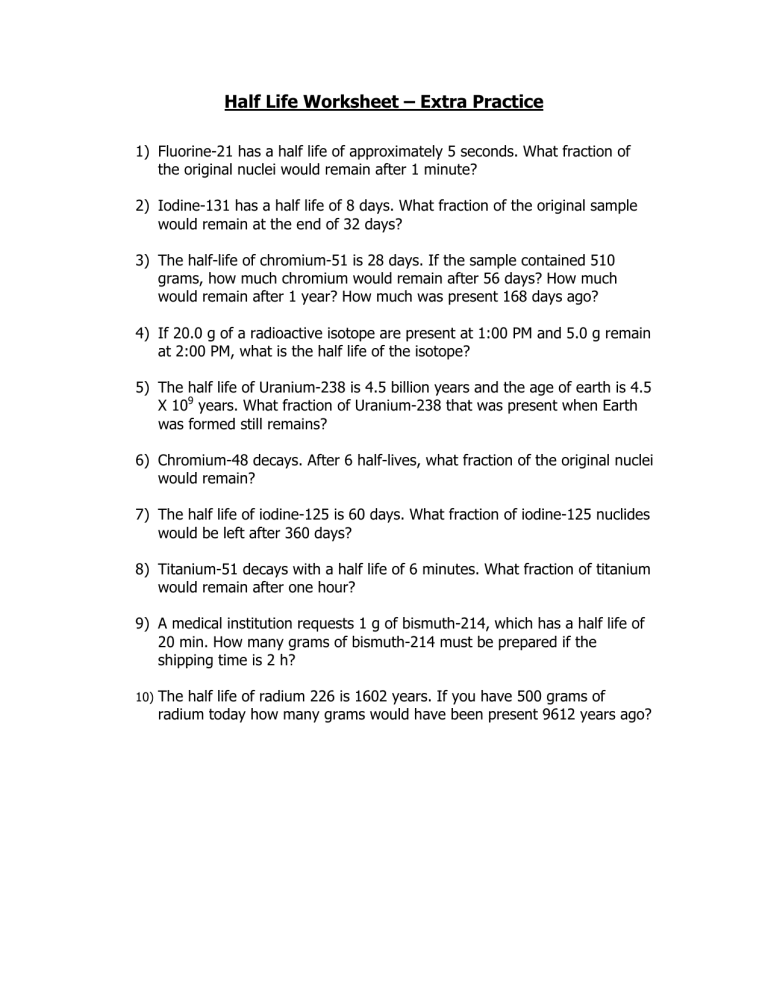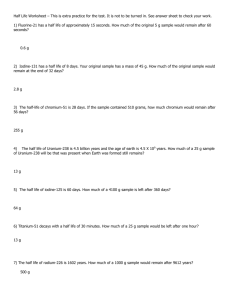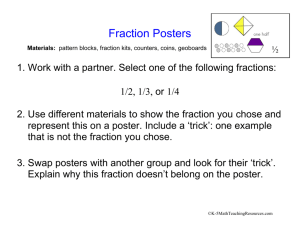Half Life Worksheet – Extra Practice - Journigan-wiki

Half Life Worksheet – Extra Practice
1) Fluorine-21 has a half life of approximately 5 seconds. What fraction of the original nuclei would remain after 1 minute?
2) Iodine-131 has a half life of 8 days. What fraction of the original sample would remain at the end of 32 days?
3) The half-life of chromium-51 is 28 days. If the sample contained 510 grams, how much chromium would remain after 56 days? How much would remain after 1 year? How much was present 168 days ago?
4) If 20.0 g of a radioactive isotope are present at 1:00 PM and 5.0 g remain at 2:00 PM, what is the half life of the isotope?
5) The half life of Uranium-238 is 4.5 billion years and the age of earth is 4.5
X 10
9
years. What fraction of Uranium-238 that was present when Earth was formed still remains?
6) Chromium-48 decays. After 6 half-lives, what fraction of the original nuclei would remain?
7) The half life of iodine-125 is 60 days. What fraction of iodine-125 nuclides would be left after 360 days?
8) Titanium-51 decays with a half life of 6 minutes. What fraction of titanium would remain after one hour?
9) A medical institution requests 1 g of bismuth-214, which has a half life of
20 min. How many grams of bismuth-214 must be prepared if the shipping time is 2 h?
10) The half life of radium 226 is 1602 years. If you have 500 grams of radium today how many grams would have been present 9612 years ago?
Half Life Worksheet – Extra Practice: Solutions
1) Fluorine-21 has a half life of approximately 5 seconds. What fraction of the original nuclei would remain after 1 minute?
1
The answer is solved by creating the fraction . Where n = the
2 n number of half lives. If each half life is 5 seconds, then in one minute
(60 seconds) there are 12 half lives. Therefore the answer is:
1 1
=
2
12
4096
2) Iodine-131 has a half life of 8 days. What fraction of the original sample would remain at the end of 32 days?
Using the same fraction, you must figure out n. If the half life is 8 days, then in 32 days, there are 4 half lives. Therefore the answer is:
2
1
4
=
1
64
3) The half-life of chromium-51 is 28 days. If the sample contained 510 grams, how much chromium would remain after 56 days? How much would remain after 1 year? How much was present 168 days ago?
In this problem, the fraction will be multiplied by the initial amount. In the first problem each half life is 28 days, therefore in 56 days two half lives occur. This means that n=2. The solution is as follows:
1
( Initial amount )
2 n
1
=
(510 g )
2 2
=
127.5
g
The second is solved the same way except that there are 13 half lives over one year. This means n=13. The solution is as follows:
( Initail amount )
1
2 n
1
=
( 510 g )
2
13
=
0 .
062 g
The third is solved by recognizing there must be more of the
sample 168 days ago then there is now. 168 days represents
3 half lives so n=3. The solution is:
1
( Initial amount )
2 n
=
Final amount
∴
Initial amount
=
Final amount
×
2 n
Initial amount
=
500 g
×
2
6
=
32000 g
=
32 kg
4) If 20.0 g of a radioactive isotope are present at 1:00 PM and 5.0 g remain at 2:00 PM, what is the half life of the isotope?
In this problem, you must figure out how many half lives have occurred.
After one half life 20.0g becomes 10.0g. After a second half life, 10.0g becomes 5.0g. This means that during the question, two half lives have occurred. Since this happened over the course of 1 hour, then each half life must be equal to:
30 minutes.
5) The half life of Uranium-238 is 4.5 billion years and the age of earth is 4.5 X 10
9
years.
What fraction of Uranium-238 that was present when Earth was formed still remains?
4.5 billion is exactly the same as 4.5 x 109. Therefore, the age of the
Earth is equal to one half life of Uranium. This means that n=1. The solution is a follows:
2
1
1
1
=
2
6) Chromium-48 decays. After 6 half-lives, what fraction of the original nuclei would remain?
1
The answer is solved by creating the fraction . Where n = the
2 n number of half lives. If there are 6 half lives, then n=6.Therefore the answer is:
2
1
6
1
=
64
7) The half life of iodine-125 is 60 days. What fraction of iodine-125 nuclides would be left after 360 days?
1
The answer is solved by creating the fraction . Where n = the
2 n number of half lives. If each half life is 60 days, then in 360 days
there are 6 half lives. Therefore the answer is:
2
1
6
1
=
64
8) Titanium-51 decays with a half life of 6 minutes. What fraction of titanium would remain after one hour?
1
The answer is solved by creating the fraction . Where n = the
2 n number of half lives. If each half life is 6 minutes, then in 1 hour (60 minutes) there are 10 half lives. Therefore the answer is:
1 1
=
2
10 1024
9) A medical institution requests 1 g of bismuth-214, which has a half life of 20 min. How many grams of bismuth-214 must be prepared if the shipping time is 2 h?
In this problem you must figure out the initial amount. If you use the same set up as question 3, then you can solve for the initial amount. You just have to figure out n. If each half life is 20 minutes, and 2 hours (120 minutes) go by, then n=6. The set up is as follows:
( Initail
1 amount )
2 n
Solving for x, x = 64g.
1
= ( x )
2
6
= 1 g
10) The half life of radium 226 is 1602 years. What fraction of a sample radium-226 would remain after 9612 years?
If each half life is 1602 years, then in 9612 years there are 6 half lives. Therefore the answer is:
1
( Initial amount )
2 n
=
Final amount
∴
Initial amount
=
Final amount
×
2 n
Initial amount
=
500 g
×
2
6
=
32000 g
=
32 kg





